Table of Contents
- Show-and-Tells for 2024
- April 2024
- March 2024
- February 2024
- January 2024
- Show-and-Tells for 2023
- December 2023
- November 2023
- October 2023
- September 2023
- August 2023
- July 2023
- June 2023
- May 2023
- April 2023
- March 2023
- February 2023
- January 2023
- Show-and-Tells for 2022
April 2024
Mark Shifter shared a new product Silhouette Silflor MiniNatur shrubbery material that can be separated into individual or small groups of plants. This has a stem with the flocking at the top. This gives a little more height to the small plants in the foreground of the scene. This is available at: https://www.eurorailhobbies.com/. So, check this product out as it comes in a number of scales.
Paul Brennecke, MMR gave us a demonstration on his technique for constructing N Scale Conifer Trees. Paul’s railroad is set in the Rocky Mountains, and the trees are primarily conifers. His layout has 3000 trees, not 4000 as reported previously. He uses toothpicks for the trunks which are 35 feet high in N scale. He paints the picks grey. The foliage material is Woodland Scenics Foliage in dark green. Again, there are various colors available, so you may alter the colors for your efforts. He hacks the foliage material into branch structure clumps about the size of one of your fingernails. Do this over a container to collect the dislodged bits of foliage. The shape of the pieces is not that important. The irregularity helps define the natural tree shape. The dislodged foliage material is used to define the crown of the tree. Just dip the toothpick into white glue and into the foliage bits and the crown is formed. The tree is formed by taking the pieces of foliage and jamming them on the toothpick. Space the branches in an irregular pattern along the length of the trunk. The pieces deform as they are forced onto the trunk. This is okay as you are wanting the variation of the pieces. Take the completed trees and mount them on foam or cardboard. Spray the trees with cheap hairspray to anchor the foliage bits and the assembled trees. The key is to plant them on the layout, and you will not be able to see the trees for the forest that is developed.
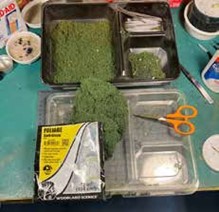
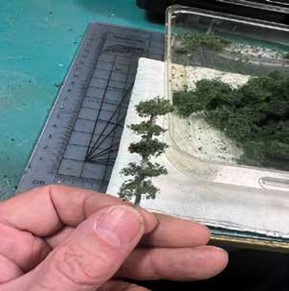

March 2024
Rich Gibson showed the progress on the Bates Mill in Lewiston, Maine. Don Meeker had a large operating layout but it was dismantled and rebuilt in the 3 year Covid period. As a part of the Livingston expansion of Rich’s layout, a space was made available for the Bates Mill. This was a complex of several buildings that would need to be compressed to fit in the available space. Rich supplied Don with photographs of the buildings, the Sanborn map, an indication of the buildings that were important to model, and the aerial view of the complex. This information was sent to Don about two months ago. The area on the layout for this complex is 46 inches by 4 inches.
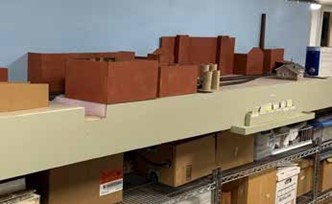
Prior to our meeting, Don indicated he had finished the complex. The completed model fills the available space to match the prototype. A little adjustment may need to be made to the one structure for the track clearance. The buildings were constructed of foam core board with textured brick sheet as the facing. The brick wraps into the window and door frames to match a completed masonry structure. The windows and doors on the complex were left over “scrap” box parts. To give life to the complex the dock areas were modeled open with figures, cotton bales, shipping boxes, and dock equipment. This gives the box car spots for the operations. The detail on the structures is very well done with interesting details.
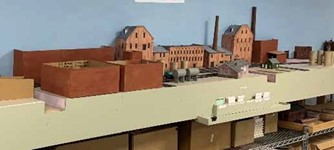

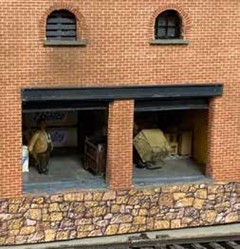
The second part to the show and tell was another floor show. Rich has laid a lot of track recently and was present at Glenn Gibson’s layout where the tracks were being laid and ballasted. A common problem in ballasting the track shoulders is that the roadbed shows through the ballast layer. Rich solved this problem by painting the roadbed shoulders with craft paint in a complementary ballast color to hide any areas of thin ballast. This takes a short amount of time and simplifies the ballasting operations. Rich demonstrated this in the middle of the crowd and over a catchment on the floor. We need to keep the area neat. One side of the track was ballasted without the paint and the other side ballasted with a painted shoulder. The difference is easily seen. Rich uses a sprinkle bottle made from any container with a screw on lid. He punches holes in the lid to allow the material to come out easily but in a controlled fashion.
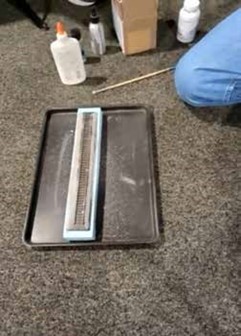
February 2024
Carl Hodkinson brought in his latest diorama with lights and smoke, really fog. It is powered by 3 separate power sources. He asked for comments on his work. Great to see Carl bringing in his creations.
January 2024
No Show-and-Tell this month.
December 2023
No Show-and-Tell this month due to the Christmas Party.
November 2023
The SS Jack Brody was in attendance for the meeting. So not only did we see the presentation on the model, but we could also study the model itself. The rigging on the slides was one thing, but seeing the complicated mass of lines in person is something else. Thanks, Glenn, for bringing this to us.
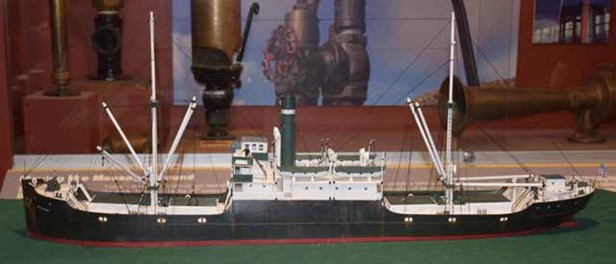
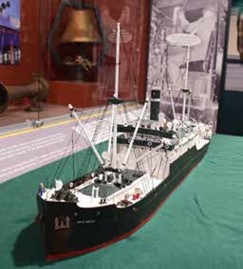
October 2023
No Show-and-Tell this month.
September 2023
Paul Brennecke brought us his submission to the NMRA Calendar Contest. Each year beginning in April, the NMRA requests submissions of photographs for the next year’s calendar. Paul usually submits some of his work for consideration. What is unique about Paul’s photos is the point of view. Using his phone to take the photos he has a vantage point about 15 scale feet above the terrain. This gives a more natural view of the model railroad as if the viewer were on the ground.




Paul replaces the sky with alternate photos of the sky to eliminate the shadows cast on the backdrop sky by trees. So, when you see the sky in Paul’s photos, it was placed there by Paul and his editing. If you see Paul out taking photos just smile and wave as you go by. Thanks for the preview of your photos to be included in the calendar. Apologies to Paul for the small images in the Telegrapher.
Roland Lawrence has been working on a Front Range Division website to give us more visibility. Take a look at https://front-range-division.org. In an effort to populate the website, Roland is requesting feedback and information you would like to add to the site. It would be great to add more FRD member layouts and information on the layouts to the site. In that instance, Roland is requesting that interested individuals send pictures and/or video, and a summary of what scale, room size, location, railroad name, setting/era and other information to describe your railroad.
Please review the site and send feedback or submissions to frd.nmra.meeting@gmail.com.

Rich Gibson brought in his recently acquired train order hoop. This is a wooden hoop with the train order paperwork clipped near the hoop which was transferred on the fly to the engineer or fireman in the locomotive. The hoop was caught on the arm of the train personnel, and the orders removed with the hoop dropped along the tracks beyond. This was a pretty precision move, and the result was bruising on the arm. The hoop was replaced by a “Y” shaped device with the orders suspended between legs of the “Y”. This is an interesting piece of Railroadiana. Thanks for sharing.
August 2023
No Show-and-Tell due to having the Picnic.
July 2023
Don Widrig brought in a Peco crossover with a broken frog lead asking for suggestions. A number of ideas were brought forth with the most promising being to attach the lead from the underside of the crossing. He also brought with him some Lionel trains that need a good home.
Gerry Glancy followed with the latest installment of the Standard Gauge / Narrow Gauge (SG/NG) Legerdemain on the Dueling Gauges Railway and Navigation Company. As you may remember last month, a SG/NG crossing was fabricated. This month we reviewed the track work for a Dual Gauge Industry, The Oriental Refinery. No commercially manufactured turnouts were available. So with starting with a Peco Narrow Gauge turnout, one may add a third rail to the outside of the diverging route to service a standard gauge siding.
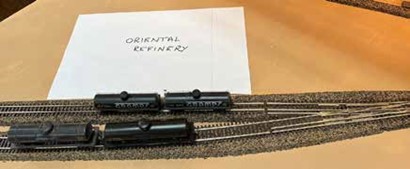
Once you have mastered the technique, additional sidings can be accommodated. The Salida Stockyard is one of those industries.
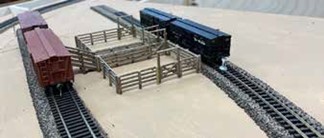
One starts with the turnout and using careful Dremel surgery grafts a third rail to the outside of the turnout on the diverging route.

For this to be a successful effort, the use of track gauges for the entire turnout is necessary.

Rich Gibson brought in a photographical study from the Jackson Thode Collection. These photos were taken in Pueblo, Colorado on December 21, 1956, which represents the last day of the Denver and Rio Grande Western Railway standard gauge steam power. The Collection shows D&RGW No. 1185 in action.
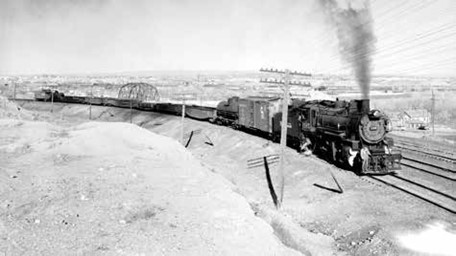
The Collection continues on to the scraping of the locomotive in Pueblo. There is a large pile of scrap accumulated along the tracks. It was a very sad day. The only good thought is the scrap lives on in wire, fence posts, structural shapes, and rail from Colorado Fuel & Iron.

Glenn Runkewich brought in the Tichy flat cars he has been modeling. These are nice looking models, but have little opportunity to add weight to be anywhere close to the NMRA standards. He went into his junk box, and found part of a track cleaning car and another tank model to add to one car. The other car received a load of two diecast vehicles to round up the weight on the car.
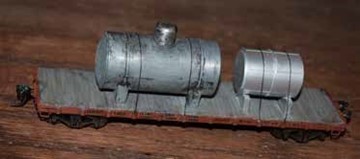

June 2023
Gary Ratay brought up some developments on European railroading in that they are putting into service passenger cars which load at platform level. This is to meet a goal the major station stops will be reduced from 5 minutes to 3 minutes. No word on the German translation for “Mind the Gap”.
Also from Gary Ratay, brought in a Ryobi one inch belt sander, model PSD101B. This is an 18 volt tool using the standard battery and is varible speed. Looks like a great tool for sanding and shaping in the tight spaces on the model railroad or modeling work. The next tool was a Ryobi USB Lithium Power Cutter Kit, model FVC51K. This is a power rotary cutter with replaceable blades and a small lithium battery. This is suitable for cutting cardboard, plastic, leather, and most importantly the bubble packaging prevalent today. Another product is the Ryobi Lithium Rotary Tool Kit, model FVM51K. This is a USB rechargeable kit. This tool performs like the heavier and less maneuverable rotary tools. The last product was a new find on Amazon of a rechargeable mini soldering iron. Just search on the site for rechargeable soldering pen as there are a number of different models for you to choose from reasonable pricing. This for Gary was a must have as the former soldering iron met with the floor and under a foot.
May 2023
Glenn Gibson started off the Show and Tell, by showing off his latest model of a Rexall Drug Store for his version of Trinidad, Colorado. The Hausman’s Riverside Drug Store was a brick structure on the bank of the Purgatoire River. The building is still there, but the use has changed. In Glenn’s version of the store the drug store occupies the first floor of the building, and the upper level is Donna’s Dance Studio. The structure is a mixture of DPM kits. The store front is from a Carr’s Parts building kit with the back and sides from the Robert’s Dry Goods kit. Dry Goods provided the rear loading dock and entrance for the dance studio. The structure was painted with Rustoleum red, grey, and white primer, finished with Tamiya light grey, Rustoleum Khaki, and the final coat was Roberts Brick Mortar. The roof was covered with Walthers Roof Texture. The Rexall sign is a Miller Engineering animated sign, and the other lighting is the Woodland Scenics “Just Plug” system components. The window signs were printed on transparency film. Other signs on the building were printed on plain paper and sanded down before being applied. The first floor interior was a City Classic Drug Store scene scanned and resized to fit the larger width of the building. The second floor figures are Woodland Scenics Swinging Sensation dancers. To highlight the second floor scene, a skylight was constructed of Tichy Train Group windows mounted on a scratch built curb. This is an interesting structure with a good level of detail for the entrance to the Trinidad model.
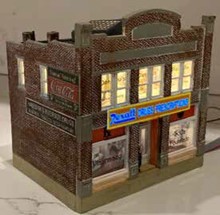
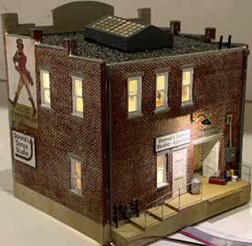
Gerry Glancy gave us an update on the Dueling Gauges Railroad and Navigation Company. The Keddie Wye from his last layout has been integrated into the current layout as an operational element. The auto reverser has been installed to keep the trains moving through the wye. At the time of the January layout tour, peninsula bench work had been constructed, but the track was not in place. With this meeting’s update; track is in place, and an active staging yard is operational. In keeping with the historic nature of the Denver area railroads, the narrow gauge line operated into Denver until 1942. The difficulty is the track plan for the Dueling Gauges Railroad necessitates the crossing of the narrow gauge line and the standard gauge line. In this instance, the rails cross at a 30º angle. That is easy. One can just find a narrow gauge and standard gauge crossing. No, you cannot. Get an Atlas 30º crossing and modify one leg to narrow gauge width. Just remove the mid-section and reattach the resulting parts to the correct gauge. One problem is the ties no longer line up to the realigned rail. Just offset the pieces to make the rails line up. The resulting piece is a little unusual but installed in the layout and ballasted, the appearance is good and operationally the crossing works as intended. Good job in making the railways work for you.

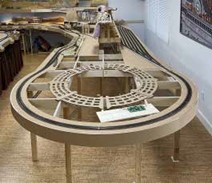

Carl Hodkinson brought in a little piece of history to show us. In the 1930’s, Lionel produced a wind-up toy handcar featuring Mickey and Minnie Mouse. This was during the Depression Era, and it was an effort to keep Lionel in business. The box contained the wind-up toy, sections of track to make a circle, and cardboard inserts printed to look like stations. The toy cost $1.00 and sold 250,000 units. The toy was reissued in the 1960’s with some differences to keep collectors from backdating the new version to the historic units. Interestingly, no mention of Lionel was on the box, it was only labeled Walt Disney. As both versions of these were wind-up toys, the spring would break and make the operating piece of the toy useless. The circular track was durable, and it begged to be used by a Lionel train. Carl brought in the 1960 version of the toy complete with the colorful box. This is an amazing instance of Disney promotion and Lionel desperation making a collectable piece of Railroadiana.

Glenn Runkewich related the recent events on his railroad and other photo equipment improvements. Needing to pay of all this, he has added vacuum cleaner salesman to his resume. He located a cordless rechargeable hand vacuum to use for cleanup on his model railroad. This is the Bissell model 29869 found on Amazon or other retailers. This is a small unit with sufficient suction to clean up static grass or ground foam without disturbing other materials.

April 2023
Rich Gibson rehabilitated a collection of Life-Like trees in an unrealistic turquoise color. He put a wire brush to the flocking and removed as much as he could. This had the effect of removing the foam but also rough shaping the tree. You can at this point re-shape the tree to better mimic natural trees. The resulting armature was painted the go-to color Rust-Oleum camouflage brown. This is a flat brown color and is useful in many model railroad applications. The armature was sprayed with 3M Super 77 adhesive and coated with green flocking. This added back the needle texture and improved the color of the tree. One may use a variety of foam colors to add variation to the trees. The result is a low cost solution to adding trees to a model railroad or diorama.
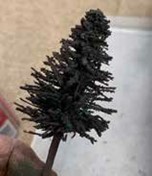
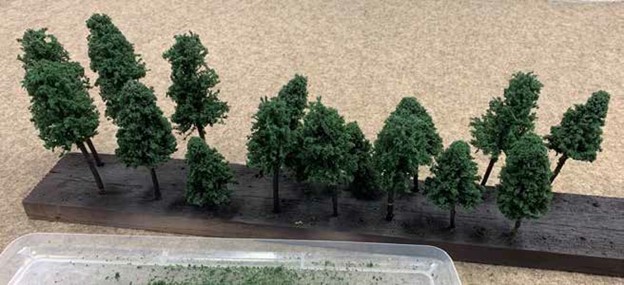
March 2023
Glenn Runkewich showed us his latest creation, the Runkewich Wedge. This is a rail car brake/holding device to immobilize a car or a string of cars on an incline. The components are simple, a ¼ inch square wood block with a small ¼ inch block of 0.100 x 0.250 styrene. Glue the styrene to the underside of the block and paint for visibility. Glenn models in HO scale so the dimensions can be adjusted for other model scales.
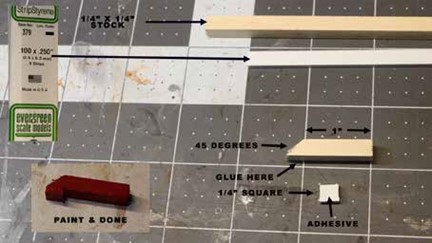
Glenn Gibson was able to display with Roland’s assistance his model of the Hotel Trinidad. This model is to be a part of Trinidad on Glenn’s AT&SF layout. The model features the wall painted signs on the side of the building with an animated HOTEL sign on the opposite side. The animated sign is a Miller Engineering sign replicating graphic neon signs of the past. Glenn explained the sign has a number of different animations which are user determined. See the animated version of the model on the transmittal email.

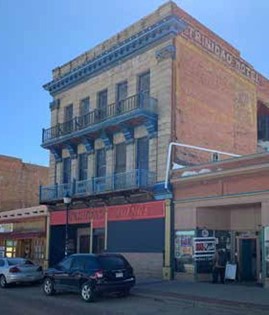
February 2023
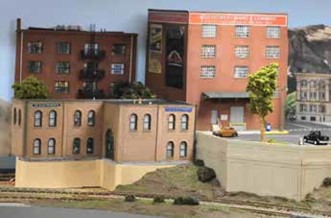
Glenn Runkewich brought us up to date on his latest efforts in the downtown area of his layout. This unit was the third of the downtown units with one more planned. The building is a train shed style building with a double staging track below the buildings. The structures are made up of Design Preservation wall modules and a Walthers Williams Electric Motor kit. The structures are lit and populated. In a building with sufficient room, Glenn will layer the photos in the windows with curtains and people, direct to the window glazing and on a foam board frame behind the windows additional photos to fit the space. A single LED lights the structure in a lightbox with the light coming through the photographs and the windows. On the narrow structure against the back drop, Glenn is constructing a lightbox with Plastruct tubing and layering all the photographs direct to the window glazing. Glenn added a Walthers Vintage Fire Escape to the building flat to add some depth to the flat. He is a little sorry he decided to add to the building as it was a difficult build. Each landing for the escape includes three parts to make up the railing, the landing itself, and an interior rail to protect the opening. Each stair section includes two railings as well. He added this to the one wall of the Williams Electric Kit, so the window spacing was compatible with the escape stair layout. The Williams Electric Kit has yielded four buildings for the city center by not following instructions. The kit is well designed with alignment pegs for the windows greatly simplifying construction. One building is the narrow flat against the backdrop with the fire escape. Montgomery Wards to the left of the flat was constructed using two walls with a loading dock.

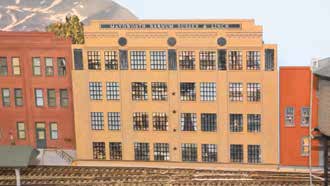
The front wall of the Williams Electric building was truncated to a garden height and added to another portion of the city scene. The art deco style entrance has been saved for more building efforts.

The final wall was a large blank brick sheet with an added loading dock area, decals, and added into the corner is a chimney. We look forward to more adventures in kit-bashing.
Don Widrig showed us his latest acquisition on the road to building a coffee table N scale
layout. His passenger service will be handled by an occasional Santa Fe doodle bug. The
unit was listed on eBay and was a DC only unit. It has now been converted to DCC with the
addition of a Digitrax decoder.
January 2023
Glenn Runkewich showed us his latest modeling efforts. This started as a Walthers kit, but Glenn added details and artfully weathered the structure to add interest. A wonderful addition to his layout, Glenn admitted he followed the instructions on the model. He built this while on the road at his cabin in Wyoming. This gives us all ideas on “bite-sized” projects that can go mobile in our travels.

Paul Brennecke’s franken engine built of SD 40-2 and SD-70 parts with a unique exhaust system. The Grand #1030 was constructed on the SD 40-2 Kato chassis after modifying the frame to allow for the SD-70 sloped engine section to fit over the remaining weight. We will see the locomotive on the Denver N-Trak group layout at a train show near you.

Rich Gibson’s newly acquired fleet of New Haven DL-109 locomotives in HO scale. An interesting locomotive that was approved for construction during WWII and used extensively by the New Haven in passenger service. Some were used by the Bangor and Aroostook hauling potatoes in northern Maine.
